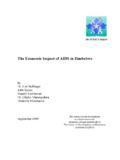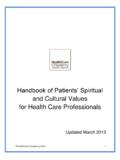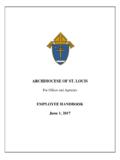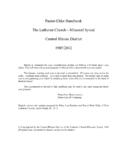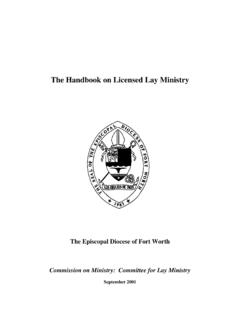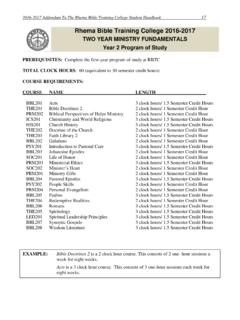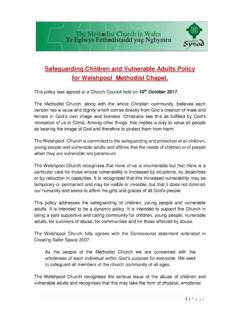Transcription of HOME BASED-CARE FOR PEOPLE LIVING WITH …
1 Republic of KenyaHOME BASED-CARE FOR PEOPLE LIVING with HIV/AIDSNATIONALHOME- based CAREPROGRAMME AND SERVICEGUIDELINESN ational AIDS/STD Control ProgrammeMinistry of HealthMay 2002iiNational Home- based care Programme and Service GuidelinesPublished by:National AIDS/STD Control ProgrammeMinistry of HealthPO Box 19361 Nairobi, KenyaEditing and publicationdesign by:Margaret CrouchDrawings by:Dorothy MigaddeTypesetting by:Lilian OhayoPrinted by:Print Options' 2002, National AIDS/STD Control ProgrammeiiiCONTENTSA bbreviations and Acronyms .. vAcknowledgements ..viForeword .. viiPART I - THE RATIONALE FOR HOME- based CARE1 Basic Information on HIV/AIDS .. is HIV? .. is AIDS? .. transmission .. 32 Home- based care as an Intervention in HIV/AIDS .. is home- based care ? .. of home- based care .. of home- based care .. care needs at various levels .. of the various players in home- based care .. 103 Components of Home- based care .
2 care .. care .. care .. support .. into the home- based care system .. 16 PART II - PROGRAMME GUIDELINES4 Planning and Setting Up a Home- based care Programme .. assessment .. programme priorities .. public sector framework .. 205 The Home- based care Team .. of HBC team members .. team members .. model home care team .. , training, and certification .. 246 Resource Mobilization .. of resources needed for effective and sustainable care .. of the required resources .. to mobilize the identified resources .. 297 Referral and Networking Systems .. referrals are necessary .. referral points .. in referral and networking .. to referral constraints .. referral framework .. 31iv8 Monitoring and Evaluation .. is monitored and evaluated in home- based care .. of monitoring and evaluation in home- based care .. monitoring and evaluation are done in home- based care .. to monitoring and evaluation.
3 To constraints .. 34 PART III - SERVICE GUIDELINES9 Clinical care .. of clinical care .. definition of AIDS .. administration .. symptoms of HIV/AIDS .. problems .. tract infections .. problems .. tract problems .. nervous system problems .. 4610 Nursing care .. Components of nursing care .. Home nursing .. Home care kits .. Nutritional needs of PLWHAs .. Caring for a child with HIV infection or AIDS .. Nursing management of common AIDS conditions in the home .. Helping with elimination (toilet) needs .. Physical therapy .. Infection prevention .. 5811 Counselling and Psycho-Spiritual care .. Spiritual/pastoral care and support .. Social support .. Counselling/psychological support .. Behaviour change support .. 6612 Palliative and Terminal care .. Palliative care .. Terminal care .. Networking in the provision of palliative and terminal care .
4 care after death .. Follow-up services for family members left behind .. 71 AnnexesBibliography .. 75 Recommended Home care Supplies and Medications .. 77 List of Contributors (1999 2000).. 78vABBREVIATIONS AND ACRONYMSACCsAIDS Control CommitteesACUAIDS Control UnitAFBAcid fast bacilliAIDSA cquired immune deficiency syndromeBDTwice a day (referring to medication)CACCC onstituency AIDS Control CommitteeCBOC ommunity- based organizationCBDC ommunity- based distributor/distributionCSFC erebral/spinal fluidCHWC ommunity health workerCMVC ytomegalovirusCNSC entral nervous systemDACCD istrict AIDS Control CommitteeDHMTD istrict Health Management TeamGITG astro-intestinal tractHBCHome- based careHIVH uman immuno-deficiency virusIECI nformation, education, and communicationINHI soniazidIVIntravenousMTCTM other to child transmissionMCHM aternal/child healthNACCN ational AIDS Control CouncilNASCOPN ational AIDS/STD Control ProgrammeNGONon-government organizationORSOral rehydration salts/solutionPACCP rovincial AIDS Control CommitteePHCP rimary health carePLWHAP erson LIVING with HIV/AIDSSTDS exually transmitted diseaseTBTuberculosisTBAT raditional birth attendantTDST hree times a dayTOTT raining of trainersTTTetanus toxoidWHOW orld Health OrganizationviACKNOWLEDGEMENTSThis guideline is the culmination of a lengthy participatory process that involved many peopleand organizations.
5 The annex to the guide contains a long list of the individuals and theorganizations they represented who took part in a series of stakeholder workshops thatreviewed the document in various stages over 1999-2000. The Ministry of Health is gratefulto all of them for their editorial team, under the direction of Dr. Kenneth Chebet, head of the National AIDS/STD Control Programme (NASCOP), was coordinated by Pauline Mwololo. Other NASCOP staff who contributed generously to reviews of the drafts of the document were CarolineNgare, Margaret Kidzuga, Cecilia Wandera, Anne Barsigo, Esther Munyiasia, BettyGathendu, Triza Kyulu, and Joseph Bwogo. Staff from a number of partner organizations alsoparticipated in framing the project and reviewing the drafts. We are especially appreciative ofthe efforts of Charles Omondi of Futures Group, Angeline Siparo and Julie Odhiambo of thePOLICY Project, and Irene Mwaponda, Joseph Kyalo, and Charles Thube of PathfinderInternational.
6 Dorothy Migadde penned the drawings for the guide. Margaret Crouch pulledthe various pieces together and edited and designed the work would not have been possible without the contribution and support of a number ofdonor partners. The Ministry is particularly grateful to the Futures Group, which provided thefunding support for the production and printing of this guide, and to the POLICY Project andPathfinder International for their contribution to the overall documentation for home-basedcare. Through these private voluntary organizations, as well, the Ministry acknowledges theimportant and continuing role of the UK s Department for International Development (DFID),which supports the Futures Group, and the United States Agency for InternationalDevelopment (USAID), which supports the POLICY Project and Pathfinder. We alsoappreciate the interest of the Kenya offices of the World Health Organization (WHO) and theJoint UN Programme on HIV/AIDS (UNAIDS).
7 To all of you, and to all others, too many to be mentioned here, who contributed in one wayor the other to this effort to improve the quality of care and the quality of life of personsinfected and affected by the HIV/AIDS epidemic, we express our gratitude. Your contributionwill have an impact on millions of lives across of HealthRepublic of KenyaviiFOREWORDThe small emblem that appears above and on the cover of this National Home- based CareProgramme and Service Guidelines carries a big message about the commitment of theGovernment of Kenya to reduce the impact of the HIV/AIDS epidemic. The separateelements of the emblem will be familiar to most of us, yet they are combined in a new andsignificant almost everyone will know that the red ribbon represents AIDS. And the family is justthat a family , but with the red AIDS ribbon superimposed to indicate that HIV/AIDS is not anaffliction of individuals only, it affects everyone.
8 The heart is widely recognized as a symbol oflove and caring. The green, too, is significant. Green is regarded by many as the colour ofhope. Thus the small emblem portrays an AIDS-stricken family surrounded by a heart full ofhope and caring. That is the message of home- based care is an approach to care provision that combines clinical services, nursingcare, counselling, and social support. It represents a continuum of care , from the healthfacility to the community to the family to the individual infected with HIV/AIDS, and backagain. The Government is committed to home- based care as a viable mechanism fordelivering services because it has important benefits for everyone on that National Home- based care Programme and Service Guidelines spells out the basiccomponents of home care services, the programmatic standards, and the requirements forservice delivery. In Part I, the guide opens with a description of HIV/AIDS and its impact onthe human body and the human community, and presents the case for home- based II walks us through the process of designing and setting up a programme to deliverhome- based care services, including such elements as the importance of a needsassessment, the composition and functions of the home care team, relationships betweenpublic and private sector efforts, and procedures for monitoring, evaluation, networking, andresource mobilization.
9 This part of the guide is intended to be flexible enough toaccommodate a variety of approaches to service delivery, but prescriptive enough to ensureprogrammatic effectiveness and service III gives details of the service components: clinical management, nursing care , andcounselling. Here we look at treatment regimens for various AIDS-related conditions,including guidelines for what to do at home and, importantly, when to seek help. Thecounselling component is particularly important, given the emotional and spiritual upheavalthe disease causes, and here we are reminded that the care in home- based care does notend when a person succumbs to the disease it must be extended to the survivors,especially children. Throughout, the guide stresses the importance of communityinvolvement. Finally, a set of annexes provide complementary information, including aglossary, a comprehensive bibliography, and a list of the contents of home care kits, as wellas a list of some of the many PEOPLE and organizations who have participated in thedevelopment of the audience for the guide is multifaceted: It includes mid level programme managers andmid and operational level health workers such as MOH personnel, ACU managers, NGO andother HBC service managers, and district/local health management teams.
10 Others areProvincial/District/Constituency AIDS Control Committees, supervisors of community healthviiiworkers, and trainers of trainers. There are related documents for other players in thedelivery of home- based care services, including a training curriculum and referencehandbook for community health workers and other health service need is urgent, as PEOPLE and organizations in all of these categories are striving toimprove the quality of life of persons LIVING with HIV/AIDS and their families. There arehundreds of thousands of such Kenyans, struggling to come to terms with their HIV-positivestatus and to cope with the illness and disability that come with AIDS. They need all our careand compassion, and the Government is committed to looking beyond prevention to thequality of life of persons LIVING with care will help us do just that, as it helps us change attitudes towards personsliving with HIV/AIDS and towards the disease itself.



